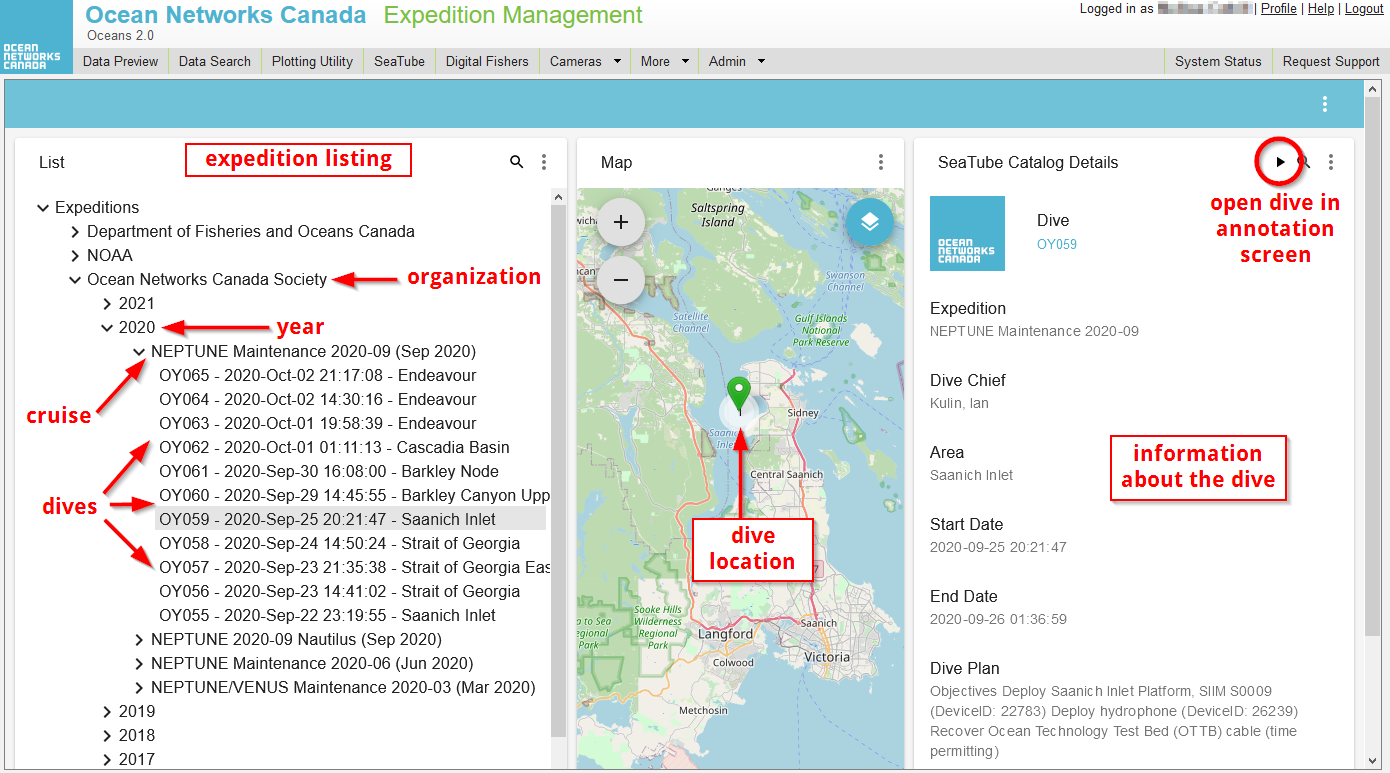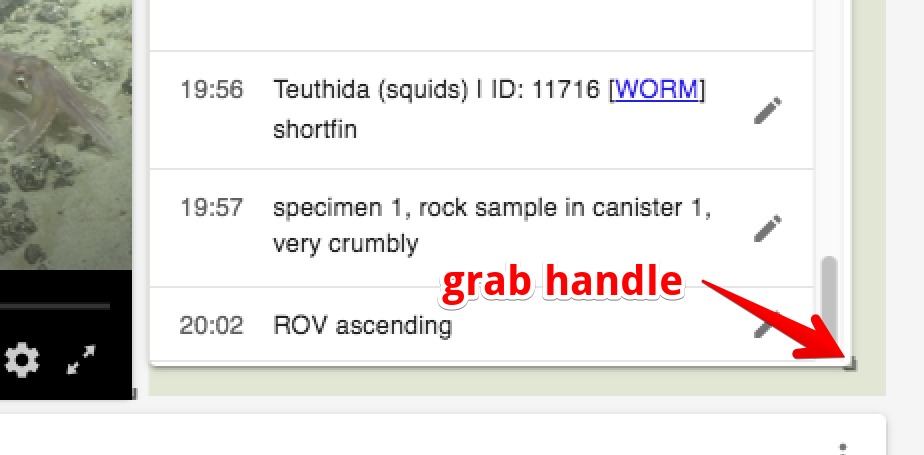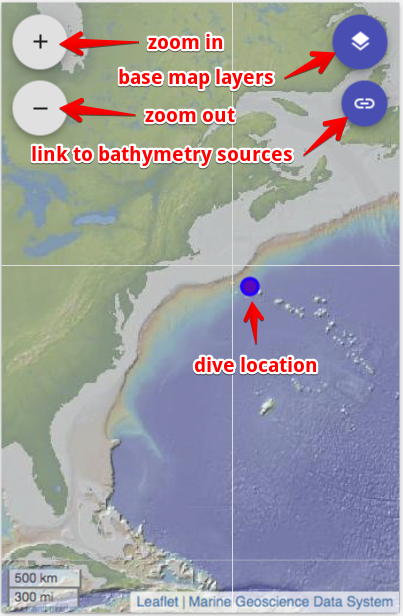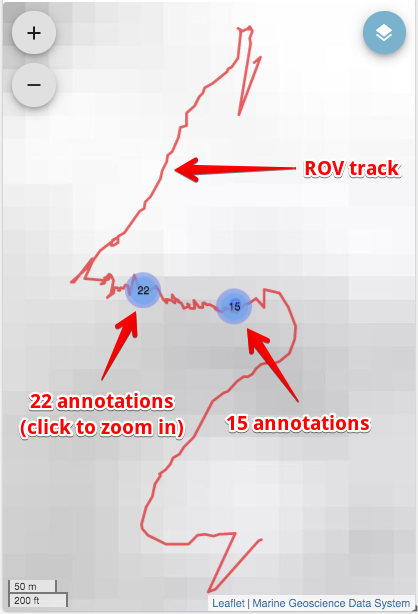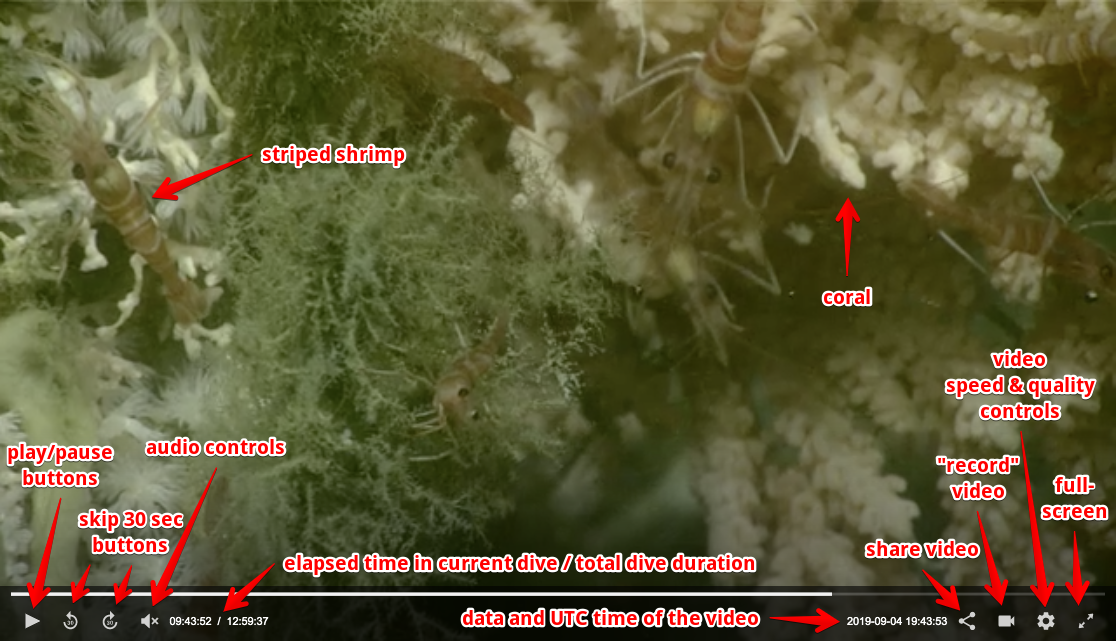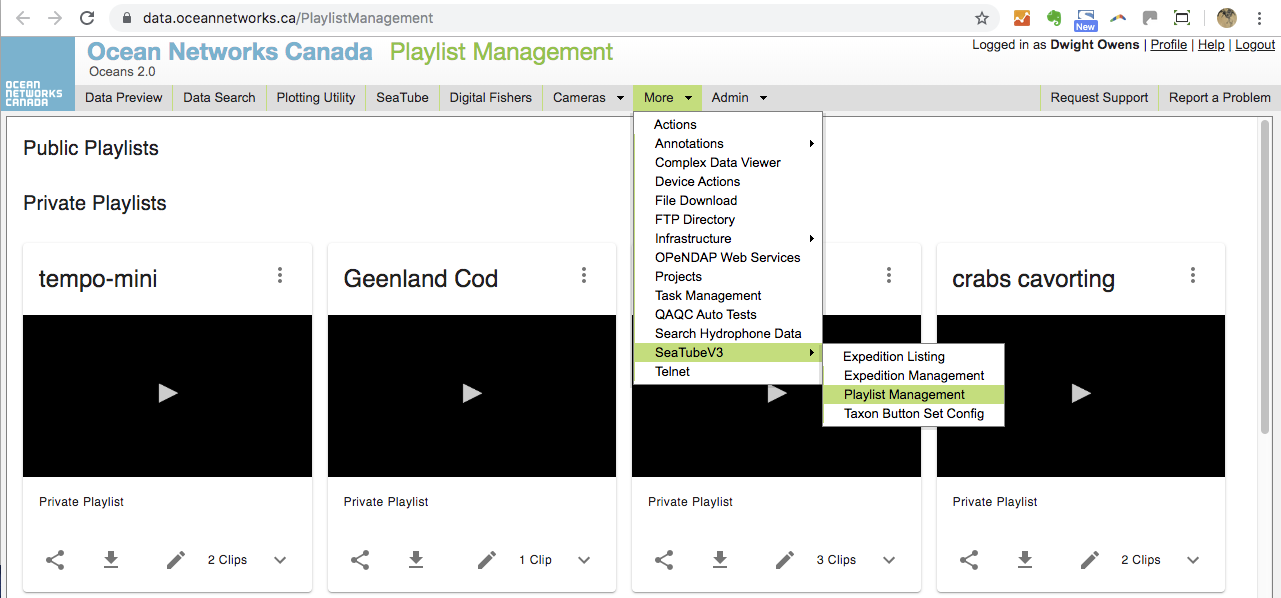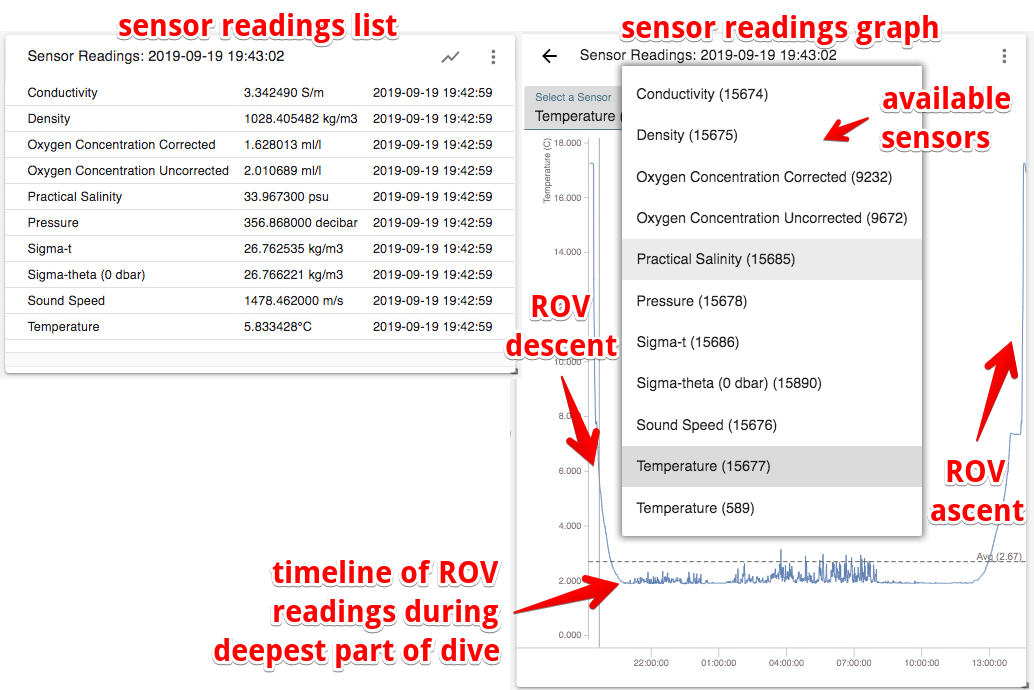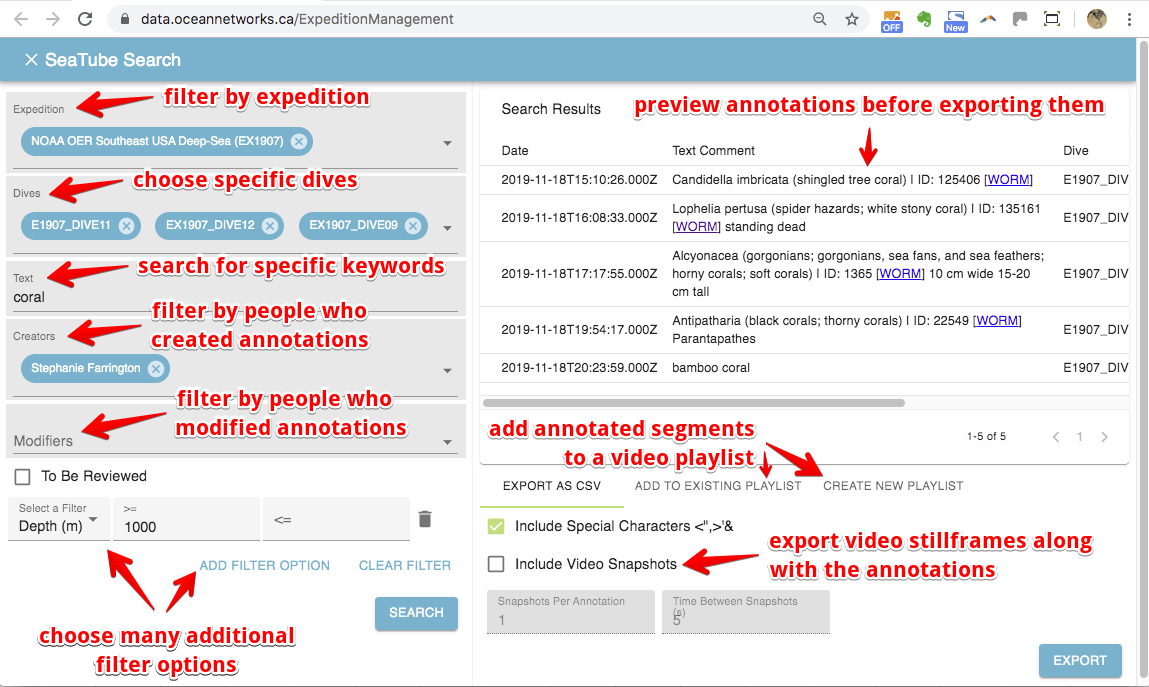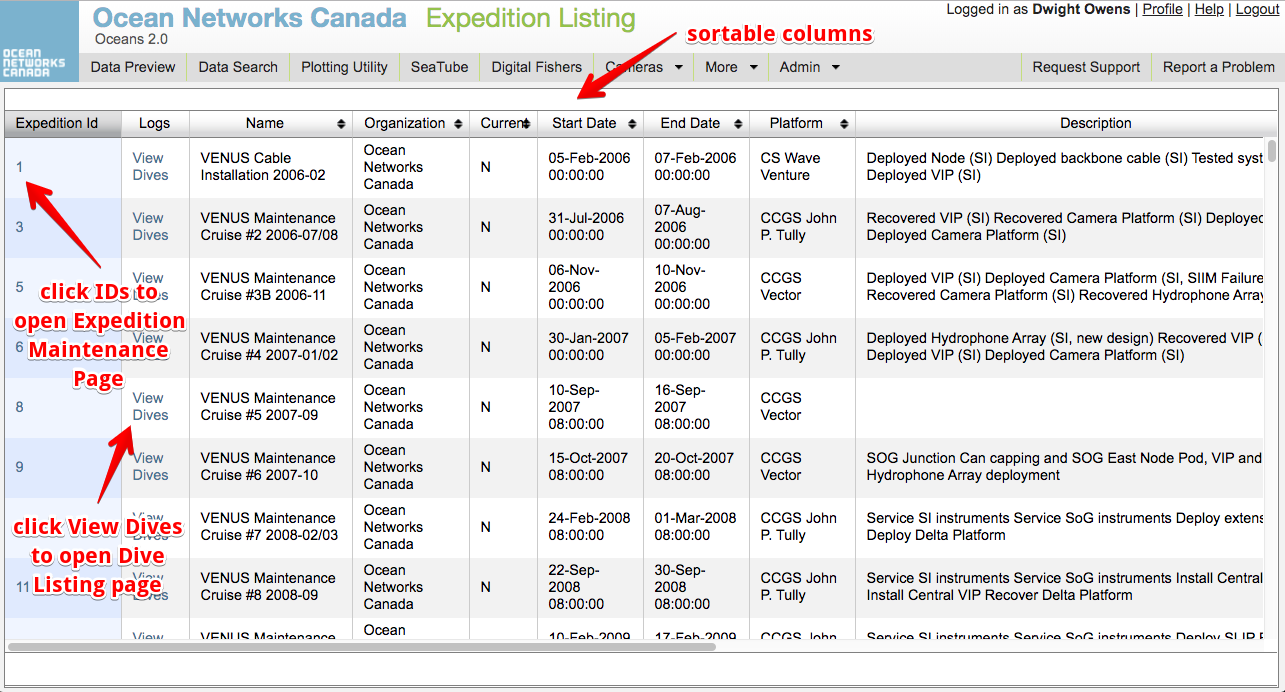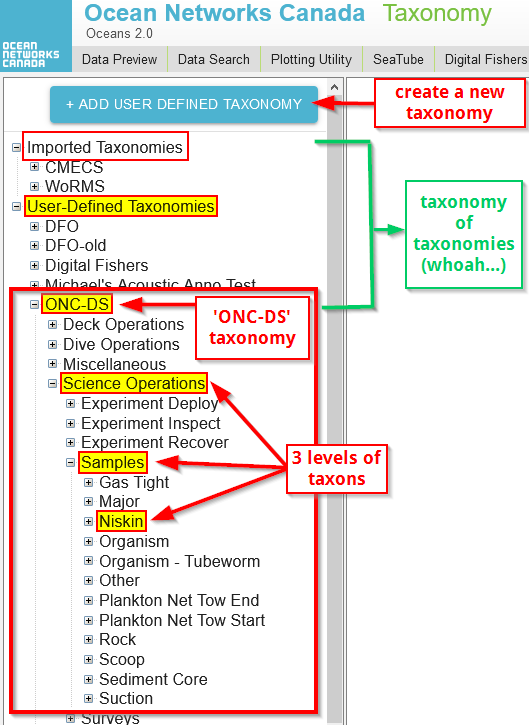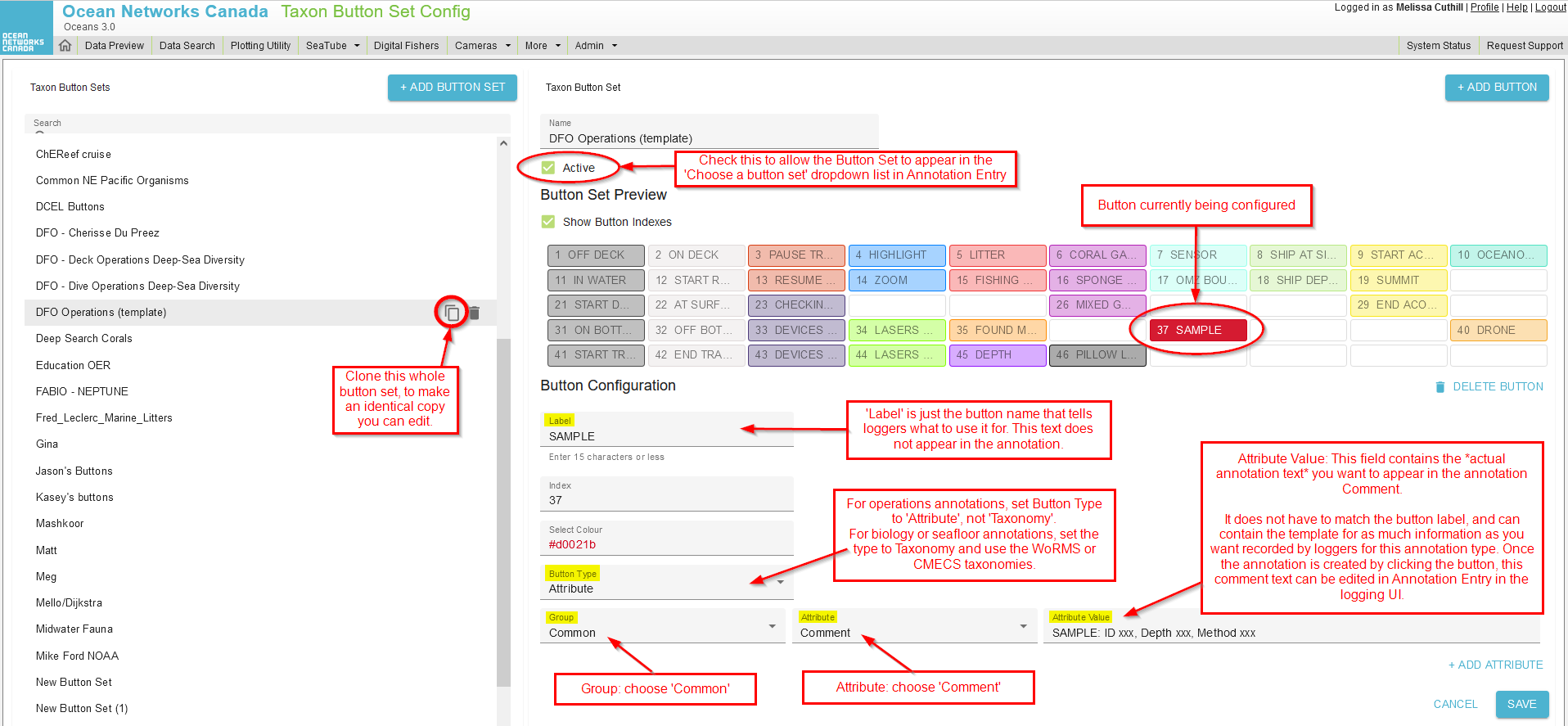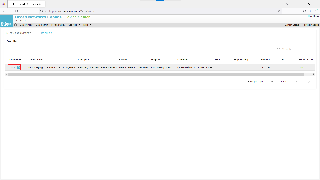Register for an Oceans 3.0 account & get more features
- You can view SeaTube without logging in, but you need an account to access and use SeaTube V3.
Related Links
What is it?
SeaTube V3 is our 3rd generation viewer and annotation tool for underwater dive videos, including these features:
- Changeable base maps
- Configurable layout
- Configurable ROV sensor display
- Quick annotation entry
- Powerful filtering and search tools
- Annotation taxonomy support + CMECS annotations
Which version should I choose?
From the main menu, you can choose which version of SeaTube to use:
If you want to view videos from fixed cameras positioned on the seafloor or onshore, use SeaTube Pro.
For viewing or annotating video from Remotely Operated Vehicle (ROV) dives, you should use SeaTube V3.
How to use SeaTube V3
1. Choose a Dive
In Expedition Management, all dives are listed by organization, year, and cruise. Find the dive you want and click on the Play button to go to the annotation interface.
2. Choose a Layout
Customize Your Layout
Optional
In addition to the predefined layouts, you can drag, resize and remove individual panels. You can also revert to predefined layouts with a single click.
3. Get to Know the Widgets
- Video: Video display and control window.
- Map: shows the location where the video was recorded. For ROV dives, the vehicle's track and annotation locations are also shown.
- Dive Details: ROV dive location, expedition, dates & times, goals.
- Annotation List: List of annotations already created for the current video.
- Annotation Entry: Tools for creating new video annotations.
- Sensor Readings: Environmental measurements recorded by sensors on the ROV or nearby the camera during the video.
Map Widget
When you open a dive in SeaTube V3, a map is displayed. This zoomable map shows seafloor bathymetry along with the track along which the Remotely Operated Vehicle (ROV) followed during the dive. Clicking a dot on the track line takes you to that point in the video.
Video Widget
- play and pause
- control audio volume and mute
- watch video at half speed, normal speed, 1.5x speed and 2x speed
- skip forward and backward 30 seconds in the video, or 5 seconds using your keyboard arrow keys
- see the video date and time
- save video clips in your personal library
- take snapshots
- choose video quality
- share a link to the video via Facebook, Twitter or URL
- expand to full screen
Recording Video Clips
After recording your video clip segments, you can view them from the Playlist Management screen:
Viewing Video Clips
You can view, describe and share recorded clips on your personal playlist via the Playlist Management screen. (Watch demo video)
Downloading Video Clips
You can also download your playlists as video clips! (Watch demo video)
Annotation List Widget
After you choose filtering options, don't forget to click Apply Filters. You can remove filtering by clicking Clear Filter.
Sensor Readings Widget
You can view readings from instruments attached to the Remotely Operated Vehicle during a dive. When first displayed, they are shown in numerical form, updated for each annotation. You can switch to graphical display sensor readings over time.
Dive Details Widget
Here you can find information about the currently selected expedition and Remotely Operated Vehicle (ROV) dive. The Oceans 3.0 video archives hold video recordings from numerous expeditions and dives by many different ROVs.
Making Annotations
Basic Annotation Entry
The annotation entry widget is both powerful and customizable.
You can use taxonomies to standardize annotation entries. This makes them easier to find by filtering as well.
Quick Entry: Button Sets
You can use button presets to enter annotations quickly—at a single click.
You can choose from button sets that have already been prepared, or you can make your own custom button sets (explained in Advanced Tools below).
Quick Entry: Keyboard Entry
You can also use keystrokes for quick entry. Use the number keys to create annotations corresponding to that button number.
Attributes
In addition to taxonomies and taxons, you can add attributes, such as count, material, or morphotype, to your annotations. Attributes are standard pieces of information that are commonly used in annotations.
Annotation Mode: Historic vs. Live
Within SeaTube V3, you are able watch and provide annotations for either Live Video (from a dive that is in progress), or Historic Video (video that has been archived for a dive in the past). Toggle between Historic and Live modes by clicking the toggle buttons in the upper-right corner of the SeaTube V3 window.
Note that this feature is only available when a dive is currently in progress; for previously completed dives Historic mode is the only option, so the toggle icons do not appear.
Historic Mode
This is the default mode for SeaTube V3 dive video, and active whenever the main SeaTube Annotation window is first opened, whether a current dive is in progress or not.
Upon entry, the Video widget will start playing the archived video from the start of the dive, and any previously entered annotations will appear in the Annotation List widget. All widgets (Map, Annotation List, and Sensor Readings) will highlight the values synced to the current video position time.
You can advance/rewind the video using the provided controls, or click on an annotation in the Annotation List to reset the video to corresponding point in time.
Creating an annotation will by default use a timestamp that corresponds to the current point in time of the video being displayed.
“Capture Time” will capture the current video time; the user may also enter/edit the time to be used using the controls provided.
Live Mode
This mode enables annotation teams to watch a live video feed and create annotations based on what they are witnessing in real-time. By default annotations that are created will utilize the current time for the timestamp (as provided by their personal computer OS).
“Capture Time” will capture the current system time; the user may also enter/edit the time to be used using the controls provided.
During Live mode, the user is not able to click on a previous annotation and watch the video from that point; in order to do so, they must switch to Historic mode.
Notes
Given the delays in receiving and re-streaming live video through SeaTube, some organizations (such as NOAA) require annotators to watch a more direct video stream to minimize these delays, but still prefer that the annotation time default to the current system time.
To enable this, the organization will provide a separate video URL for their users to watch in one browser window, while entering annotations via SeaTube V3 in a separate browser window.
To make sure the user is not confused with more than one video stream playing at once, they configure SeaTube V3 to not display any video while in Live mode.
Both NOAA and ONC are working on an enhanced solution that would allow the video time to be embedded directly in the video itself, which will resolve the original issue of the time delays between receiving a video stream and creating an annotation for a precise point in time.
Searching Annotations
Seatube Search
In addition to the filter search in Annotation List, you can search through all video annotations to find video segments and annotations of interest. SeaTube Search allows you to scope your search by expedition(s), dive(s) and many other filter parameters.
Managing Expeditions & Dives
Expedition Listing
The Expedition Listing page shows all expeditions catalogued within Oceans 3.0 since 2006. Not all expeditions had ROV dives with video recordings.
- Click a column header to sort the list by that column in ascending order; click it a second time to sort in descending order.
- Click the Expedition ID for details about it; this takes you to its Expedition Maintenance page.
- Click View Dives for an expedition to open its Dive Listing page, where you can see a list of all catalogued dives from that expedition.
- Expeditions are usually set up by ONC Data Stewardship staff.
Create a New Dive
Users with administrative permissions can create their own Dives through the Expedition Management page.
To add a dive to an expedition, select the expedition from the list and then click on the 3-dot More button in the SeaTube Catalog Details panel:
Click 'Create Dive':
A popup window will appear for you to enter dive information:
Advanced Tools
Taxonomies
Taxonomies are hierarchical lists of standardized annotation types called taxons. There are two kinds of taxonomies in STv3: Imported and User-Defined.
If you have admin privileges for your organization in SeaTube v3, you can create and edit User-Defined taxonomies in Taxonomy Management.
The taxonomy list
Attributes
New attributes can be created by admins in Attribute Management. Attributes can be organized into custom Attribute Groups to make them easier to find.
Buttons
Custom Quick-entry Buttons
You can create your own custom button sets using the Taxon Button Set Configuration screen. Buttons are based on either taxonomies or attributes.
You can also clone existing button sets, creating an identical copy that you can edit.
On-ship Dive Logging
The SeaTube V3 dive logging functionality can be implemented on different ships that ONC uses to conduct field work, and supports logging dives on many different Remotely Operated Vehicles (ROV). ONC can also provide this service to other organizations that wish to use this tool during their expeditions. The system supports simultaneous dive loggers, ships, and ROVs that may be required for operations. If a satellite connection is available, the dive logs can be synchronized between ship and shore. Otherwise, the dive logs are synchronized once the ship-based server is back on-shore.
Two quick-reference guides have been created to support our clients that are using this tool (in addition to all the other help information in this page):
Expert Review
View the SeaTube V3 Expert Review Help page for information on how to review annotations and get your name accredited to ONC published datasets!
Citing Video/Images in Publications
To cite video or images in publications, navigate to the Dataset Landing Page for the relevant camera deployment, and use the DOI.
| SeaTube V3 (ROV video/stills) | SeaTube Pro (fixed camera video/stills) | |
|---|---|---|
| Step 1. Find/Open the Device Listings page for the camera | For dive video in SeaTube V3 (ROV camera video/stills), click on the Settings cog at the lower right of the video panel and select Video Information. In the pop-up panel, select the device ID for the camera. Also take note of the timestamp for the video file. Open a Device Search page in Oceans 3.0 (More > Infrastructure > Device Search) and paste the camera device ID into the Device ID field, then click 'RUN SEARCH' In the RESULTS tab, click on the link to the Device Listings page for the camera | For video from a fixed location camera in SeaTube Pro, click on the 'Details' link in the Detail tab to open the Device Listing page for the camera. Skip the next 3 steps. |
| Step 2. Go to Site tab, open Site Device page | Select the Site tab in the Device Listings page, and click on the link to the Site Device for the relevant deployment of the camera | |
| Step 3. Open Dataset Landing Page | In the Site Device page, click on the link to the Dataset Landing Page (under DOI Datasets) | |
| Step 4. Use the DOI in publications, using the format shown under 'DOI Citation'. | ||
| Demo videos | (Watch demo video for citing ROV dive video SeaTube V3) | (Watch demo video for citing fixed camera video SeaTube Pro) |
| See also | How to cite ONC data https://www.oceannetworks.ca/data/how-to-cite-onc/ | |

